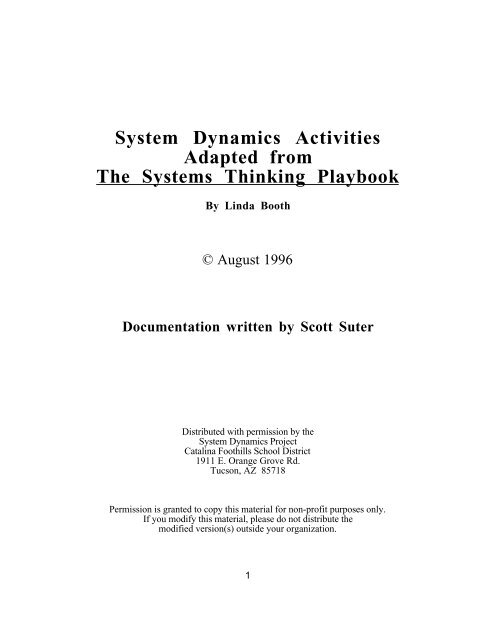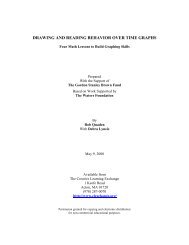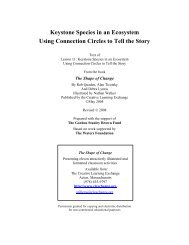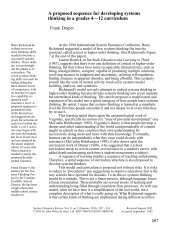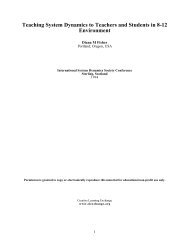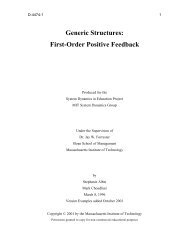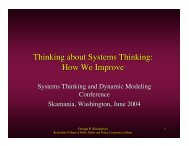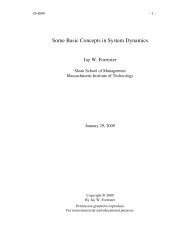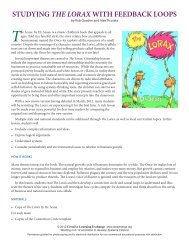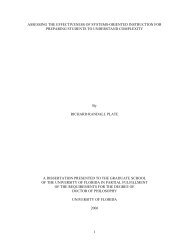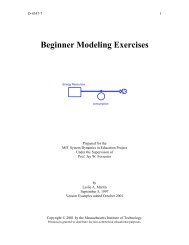System Dynamics Activities Adapted from The Systems Thinking ...
System Dynamics Activities Adapted from The Systems Thinking ...
System Dynamics Activities Adapted from The Systems Thinking ...
Create successful ePaper yourself
Turn your PDF publications into a flip-book with our unique Google optimized e-Paper software.
<strong>System</strong> <strong>Dynamics</strong> <strong>Activities</strong><strong>Adapted</strong> <strong>from</strong><strong>The</strong> <strong>System</strong>s <strong>Thinking</strong> PlaybookBy Linda Booth© August 1996Documentation written by Scott SuterDistributed with permission by the<strong>System</strong> <strong>Dynamics</strong> ProjectCatalina Foothills School District1911 E. Orange Grove Rd.Tucson, AZ 85718Permission is granted to copy this material for non-profit purposes only.If you modify this material, please do not distribute themodified version(s) outside your organization.1
<strong>System</strong> <strong>Dynamics</strong> <strong>Activities</strong><strong>Adapted</strong> <strong>from</strong><strong>The</strong> <strong>System</strong>s <strong>Thinking</strong> PlaybookBy Linda Booth<strong>The</strong> activities in this packet are dependent on the user having access to <strong>The</strong><strong>System</strong>s <strong>Thinking</strong> Playbook. <strong>The</strong>y have been adapted <strong>from</strong> activities that aredesigned to be used to teach organizational learning in business. I have listedsome possible integration areas, but by no means are these the only places theseactivities can be used.If you find different areas of integration, or different ways to use theactivities, please direct your feedback to your <strong>System</strong>s Mentor.2
Arms Crossed/Hands ClaspedGrade level: 5Lesson outcomes: To encourage students to look at the often uncomfortableand awkward feelings associated with some learning situations, such as HumanGrowth and Development.Integration area(s): This is a great set activity for the Human Growth andDevelopment unit. It helps students to step out of their “comfort zone”.Preparation: See <strong>The</strong> <strong>System</strong>s <strong>Thinking</strong> Playbook, pages 16-18, for detailedinstructions.Closure/Debrief: How does the need to be comfortable and secure and avoidfeeling awkward sometimes get in the way of learning about our reproductivesystems?Resources: <strong>The</strong> <strong>System</strong>s <strong>Thinking</strong> Playbook, By Linda Booth©1995 by Linda Booth3
Circles In <strong>The</strong> AirGrade level: 5Lesson outcomes: Students will see the possibility that their viewpoints dependon where they “sit”.Integration area(s): This activity can be done during the Slavery unit to helpstudents see the perspectives of the slaves, the abolitionists, and the slave owners.Preparation: See <strong>The</strong> <strong>System</strong>s <strong>Thinking</strong> Playbook, pages 19-23, for detailedinstructions.Closure/Debrief: Students tend to cling to the idea that the slave owners werebad people. This exercise may help them realize that the cotton, tobacco, andindigo prices made agriculture without slaves virtually impossible prior to theoutlawing of slavery. In the 1700’s-1800’s in the South, the difference betweenwealth and poverty was in the ability to own slaves, whether the practice ofslavery was humane or not.Resources: <strong>The</strong> <strong>System</strong>s <strong>Thinking</strong> Playbook, By Linda Booth©1995 by Linda Booth4
Mind GroovingExercise IIEverything But SleepGrade level: 5Lesson outcomes: Enhance students’ ability to better understand their ownthinking processes.Raise student awareness on how often automatic thought processes can obstructlearning, communication, and systems thinking.Integration area(s): This activity could be used during the first week ofschool to focus students on what mental models are.Preparation: See <strong>The</strong> <strong>System</strong>s <strong>Thinking</strong> Playbook, pages 12-13, for detailedinstructions.Closure/Debrief: Although students may not answer exactly as the booksuggests, there will likely be a large number who will. If the students have asimilar response, a discussion may follow as to why this has occurred. If theactivity does not go as planned, a discussion may still follow that describes whatusually happens and why the students didn’t give the typical response (ie. theirminds may not be as deeply grooved as an adult, or grooved differently in thatthey are not part of the same generation).Resources: <strong>The</strong> <strong>System</strong>s <strong>Thinking</strong> Playbook, By Linda Booth©1995 by Linda Booth5
Mind GroovingExercise IIIOak, Joke, CroakGrade level: 5Lesson outcomes: Enhance students’ ability to better understand their ownthinking processes.Raise student awareness on how often automatic thought processes can obstructlearning, communication, and systems thinking.Integration area(s): This activity could be used during the first week ofschool to focus students on what mental models are.Preparation: See <strong>The</strong> <strong>System</strong>s <strong>Thinking</strong> Playbook, pages 13-14, for detailedinstructions.Closure/Debrief: Although students may not answer exactly as the booksuggests, there will likely be a large number who will. If the students have asimilar response a discussion may follow as to why this has occurred. If theactivity does not go as planned, a discussion may still follow that describes whatusually happens and why the students didn’t give the typical response (ie. theirminds may not be as deeply grooved as an adult, or grooved differently in thatthey are not part of the same generation).Resources: <strong>The</strong> <strong>System</strong>s <strong>Thinking</strong> Playbook, By Linda Booth©1995 by Linda Booth6
Mind GroovingExercise IVSimon SaysGrade level: 5Lesson outcomes: Enhance students’ ability to better understand their ownthinking processes.Raise student awareness on how often automatic thought processes can obstructlearning, communication, and systems thinking.Integration area(s): This can be used with the Industrial Revolution unit toshow how inventors are likely to think about their thinking. It can also be used toshow the systemic aspects of the inventing process. After doing this activity,students will have an easier time planning their inventions.Preparation: See <strong>The</strong> <strong>System</strong>s <strong>Thinking</strong> Playbook, page 15, in the “VoicesFrom <strong>The</strong> Field” section for detailed instructions.Closure/Debrief: Students could describe how their “mind groove” effectstheir thinking, and how stepping out of the groove may increase the quality andcreativity of their inventions.Resources: <strong>The</strong> <strong>System</strong>s <strong>Thinking</strong> Playbook By Linda Booth©1995 by Linda Booth7
Thumb WrestlingGrade level: 5Lesson outcomes: To practice the art of seeing unintended consequences.Students will see that their mental models affect the actions they take.Integration area(s): This activity can be used during the IndustrialRevolution unit to show students that careful thought and planning can perhapsprevent unintended consequences in the long run. This will help students tosuccessfully plan out their inventions.An integration into the Women’s Suffrage Movement could be that prior to themovement, the prevalent mental models about women and their role in societydid not support women voting. Or an example <strong>from</strong> slavery...if peoples’ mentalmodel was that Africans were less intelligent, it might be a justification forslavery.Preparation: See <strong>The</strong> <strong>System</strong>s <strong>Thinking</strong> Playbook, pages 24-27, for detailedinstructions.Closure/Debrief: Ask students what their “mental models” are in regard to thegame of thumb wrestling. (ie. whenever they played the game in the past, theobject was for one person to get more points than the other.) Point out tostudents that the directions were to get as many points as possible, not to get morepoints than their opponent. Ask the students to discuss winning and losingstrategies, and perhaps try the exercise again. Discuss unintended consequenceswith the students in the context of an invention (ie. internal combustion enginescausing air pollution).Resources: <strong>The</strong> <strong>System</strong>s <strong>Thinking</strong> Playbook, By Linda Booth©1995 by Linda Booth8
Warped JugglingGrade level: 5Lesson outcomes: Students will see that teamwork and team planning cangreatly increase their ability to succeed. Students will also be able to explore theautomatic nature of their assumptions.Integration area(s): This activity can be used during the first week ofschool to encourage teamwork.Preparation: See <strong>The</strong> <strong>System</strong>s <strong>Thinking</strong> Playbook, pages 32-38, for detailedinstructions.Closure/Debrief: Discuss with the students what strategies they used toimprove their performance and how they may use this information in the future.You may introduce the “Limits to Success” archetype at this time.Resources: <strong>The</strong> <strong>System</strong>s <strong>Thinking</strong> Playbook, By Linda Booth©1995 by Linda Booth9
Balancing TubesGrade level: 5Lesson outcomes: Students will see that different participants in the Civil Warhad different perspectives of how the war played out. Many, who were “lookingat the hand”, thought the war would be over quickly while others, who were“looking at the whole system”, realized that it would be a long and bloody affair.Integration area(s): This activity can be used during the Civil War andReconstruction unit.Preparation: See <strong>The</strong> <strong>System</strong>s <strong>Thinking</strong> Playbook II, pages 43-48, for detailedinstructions. Note: I have found that cone shaped “tubes” work best. I also colorthe bottom inch to help students to focus on their hand instead of looking up thetube.Closure/Debrief: Discuss with the students why they were more successfullooking at the whole system rather than focusing on one part of it. Students willoften compare this to General Scott’s Anaconda Plan, which initially was laughedat because most people didn’t think the war would last long.Resources:<strong>The</strong> <strong>System</strong>s <strong>Thinking</strong> Playbook II, By Linda Booth Sweeney©1996 by Linda Booth Sweeney10
Hands DownGrade level: 5Lesson outcomes: Enhance students’ ability to better understand their ownthinking processes.Raise student awareness on how often automatic thought processes can obstructlearning, communication, and systems thinking.Integration area(s): This activity can be used anytime throughout the year toincrease awareness of mental models and “going wide”, which is a systemsthinking term for using mental peripheral vision to see complex cause and effectrelationships.Preparation: See <strong>The</strong> <strong>System</strong>s <strong>Thinking</strong> Playbook II, pages 9-15, for detailedinstructions.Closure/Debrief: This activity lends itself to the introduction of “<strong>The</strong> LadderOf Inference” that is described in <strong>The</strong> Fifth Discipline Fieldbook by Peter Senge,pages 242-246. It is also a way to revisit the concept of mental models.Resources:<strong>The</strong> <strong>System</strong>s <strong>Thinking</strong> Playbook II, By Linda Booth Sweeney©1996 by Linda Booth Sweeney<strong>The</strong> Fifth Discipline Fieldbook, by Peter Senge, et al.©1994, Doubleday, New York.11
Paper TearGrade level: 5Lesson outcomes: Students will see that multiple interpretations can beobtained <strong>from</strong> the same message.Integration area(s): This activity can be used any time you wish heightenlistening and communication skills.Preparation: See <strong>The</strong> <strong>System</strong>s <strong>Thinking</strong> Playbook II, pages 31-35, for detailedinstructions.Closure/Debrief: Ask students how this experience is similar to experiencesthat they have had. Discuss how they communicate and how they arecommunicated to. How can we improve “communication” as listeners? ...ascommunicators? Whose responsibility is it?Resources:<strong>The</strong> <strong>System</strong>s <strong>Thinking</strong> Playbook II, By Linda Booth Sweeney©1996 by Linda Booth Sweeney12
Touch BaseGrade level: 5Lesson outcomes: Students will see that teamwork and team planning cangreatly increase their ability to succeed. Students will also realize the strength analliance can have when they work together for a common goal.Integration area(s): This activity can be used during World War I orWorld War II to show the value of teamwork and alliances.Preparation: See <strong>The</strong> <strong>System</strong>s <strong>Thinking</strong> Playbook II, pages 49-53, for detailedinstructions.Closure/Debrief: Discuss with the students what strategies they used toimprove their performance and how they may use this information in the future.You may introduce the “Limits to Success” archetype at this time.Resources:<strong>The</strong> <strong>System</strong>s <strong>Thinking</strong> Playbook II, By Linda Booth Sweeney©1996 by Linda Booth Sweeney13
1-2-3 Go!Grade level: 5Lesson outcomes: Enhance students’ ability to better understand their ownthinking processes.Raise student awareness on how often automatic thought processes can obstructlearning, communication, and systems thinking. Good listening skills make for abetter systems thinker. By listening to understand, students get a better sense of“the system”.Integration area(s): This activity can be used anytime throughout the year toincrease awareness of mental models and “going wide”, which is a systemsthinking term for using mental peripheral vision to see complex cause and effectrelationships.Preparation: See <strong>The</strong> <strong>System</strong>s <strong>Thinking</strong> Playbook II, pages 60-64, for detailedinstructions.Closure/Debrief: This activity lends itself to the introduction of “<strong>The</strong> LadderOf Inference” that is described in <strong>The</strong> Fifth Discipline Fieldbook by Peter Senge,pages 242-246. It is also a way to revisit the concept of mental models.Resources:<strong>The</strong> <strong>System</strong>s <strong>Thinking</strong> Playbook II, By Linda Booth Sweeney©1996 by Linda Booth Sweeney14
Dog Biscuits & See SawsGrade level: 5Lesson outcomes: Students will see how balancing systems operate and howdelays may effect the system.Integration area(s): This activity can be used during the Prosperity andDepression unit to demonstrate balancing systems.Preparation: See <strong>The</strong> <strong>System</strong>s <strong>Thinking</strong> Playbook II, pages 65-71, for detailedinstructions.Closure/Debrief: Discuss with the students the different balancing systems thatoccur within an economy, such as supply, demand, and price.Resources:<strong>The</strong> <strong>System</strong>s <strong>Thinking</strong> Playbook II, By Linda Booth Sweeney©1996 by Linda Booth Sweeney15
Toothpick TeaserGrade level: 5Lesson outcomes: Students will see that inventors often used divergent thinkingto come up with their ideas. <strong>The</strong>y will also see that looking at a problem <strong>from</strong>many perspectives may help them to solve the problem.Integration area(s): This activity can be used during the IndustrialRevolution unit.Preparation: See <strong>The</strong> <strong>System</strong>s <strong>Thinking</strong> Playbook, pages 39-43, for detailedinstructions.Closure/Debrief: Discuss with the students the concept of thinking outside oftwo dimensions and how they began to figure out how to solve the problem. (Youmay need to give a hint so students will try standing the sticks up.)Resources: <strong>The</strong> <strong>System</strong>s <strong>Thinking</strong> Playbook, By Linda Booth©1995 by Linda Booth16
5 Easy PiecesGrade level: 5Lesson outcomes: Students will see that teamwork, as opposed to individualsuccess, will help them to achieve the goal.Integration area(s): This activity can be used during the IndustrialRevolution, World War I, World War II, or any time you wish toencourage teamwork.Preparation: See <strong>The</strong> <strong>System</strong>s <strong>Thinking</strong> Playbook, pages 44-47, for detailedinstructions.Closure/Debrief: Have students who could see what the others in their groupneeded to do tell what it felt like not to be able to tell them. Have students thathad to break up their square so that the group could succeed share what that waslike. Discuss how assembly lines or alliances relied on many people workingtogether.Resources: <strong>The</strong> <strong>System</strong>s <strong>Thinking</strong> Playbook, By Linda Booth©1995 by Linda BoothTo order <strong>The</strong> <strong>System</strong>s <strong>Thinking</strong> Playbook, volumes I or II, contact Terri Sever at Turning PointFoundation 508-650-0138——Fax 508-650-018417


